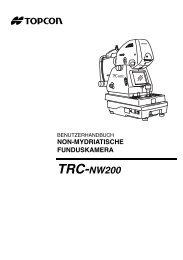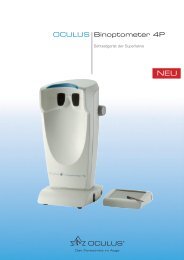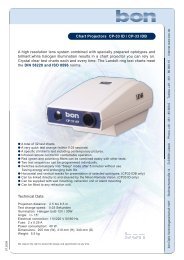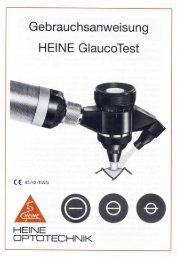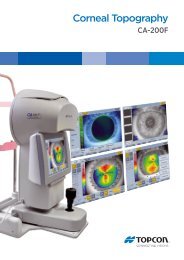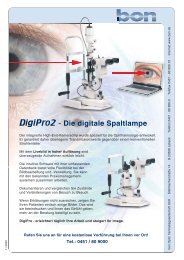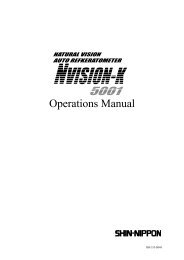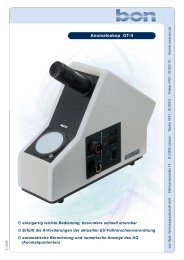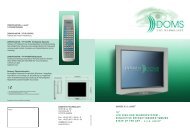boor versie Kraai Ophthalmics.pmd
boor versie Kraai Ophthalmics.pmd
boor versie Kraai Ophthalmics.pmd
Create successful ePaper yourself
Turn your PDF publications into a flip-book with our unique Google optimized e-Paper software.
MW-111<br />
MW-111/A<br />
MW-111/B<br />
MW-111/C<br />
MW-111/T<br />
WRONG<br />
MAUVAIS<br />
FOUT<br />
Delivery program<br />
0344<br />
RIGHT<br />
CORRECT<br />
GOED<br />
Rustringremover in case, with battery<br />
and set of burrs MW-111/A<br />
Set of six standard burrs for the rustringremover,<br />
three sizes, 010, 012 and 016<br />
Set of six finest burrs for the<br />
rustringremover, size 006<br />
Empty case with insert for the complete<br />
rustringremover set<br />
Empty case for six burrs of the rustringremover<br />
Manufactured by:<br />
<strong>Kraai</strong> Ophthalmic Instruments<br />
Leuringslaan 44/2<br />
9356 VM TOLBERT - NL<br />
RUSTRINGREMOVER<br />
Rustringremover MW-111<br />
Fraise à corps étrangers MW-111<br />
Roestring<strong>boor</strong> MW-111<br />
P.O.Box 461<br />
9700 AL GRONINGEN<br />
The Netherlands<br />
Phone +31 50 527 69 99<br />
Fax +31 50 527 69 58<br />
E-mail: info@medicalworkshop.nl<br />
www.medicalworkshop.nl
INSTRUCTIONS (ENGLISH)<br />
The instrument operates on a single AA size<br />
penlight battery which is housed in the handle.<br />
This handle is unscrewed counter-clockwise for<br />
battery replacement. The motor uses little<br />
energy and one battery should deliver full power<br />
for the equivalent of three hours of continuous<br />
operation.<br />
If the instrument is not used frequently, we<br />
advise to remove the battery, as discharged<br />
batteries may swell, leak or cause corrosion.<br />
The motor is started by pressing the switch<br />
near the top of the instrument handle. Should<br />
the motor fail to start (with a fresh battery in<br />
place) check contact point for corrosion. If<br />
necessary, clean with emery cloth or a stroke<br />
with a nailfile.<br />
The friction chuck is designed to accomodate<br />
the specially designed (Medical Workshop) short<br />
shank dental burr. An assortment of 6 burrs is<br />
included with the instrument. The sizes have<br />
been carefully selected to handle most of the<br />
encountered rustring sizes. The burrs are<br />
removed by grasping the head firmly between<br />
thumb and forefinger and pulling directly away<br />
from the instrument.<br />
Suggestions for use<br />
The type of burr supplied performs a superficially<br />
scraping action (not a drilling action) while there<br />
is no danger of perforating the cornea. The instrument<br />
can be used with a slitlamp, a simple<br />
head loupe or even directly (unmagnified).<br />
Choose a burr somewhat larger than the rustring<br />
to be removed; that is, large enough to<br />
contact the entire circumference of the ring at<br />
a single touch (see drawing).<br />
Place the burr against the rustring, push the<br />
switch and use a to-and-from circular movement,<br />
like the motion used when shaving with an<br />
electric razor. It often helps to indent the cornea<br />
slightly so that the ring is folded around the<br />
burr as the scraping action takes place. Healthy<br />
corneal tissue resists the scraping action while<br />
the foreign material will be removed quickly and<br />
effectively.<br />
Sterilization<br />
Only the burrs need sterilization. The instrument<br />
itself should only be wiped off occasionally<br />
with a little alcohol. Under no circumstances<br />
should the motor be exposed to high temperature<br />
sterilization or immersed in liquids.<br />
Attention!<br />
We recommend to remove the battery, when<br />
the instrument is not in use.<br />
Burrs are made of stainless steel.<br />
Sterilization of burrs by ETO, dry heat or<br />
autoclave. Maximum sterilisation temp.<br />
134°C. At least 20 min. at 121°C and/or at<br />
least 5 min. (or 18 min. at prion deactivation)<br />
at 132°C.<br />
To guarantee a long life of your instrument, use<br />
only original burrs, available through your dealer.<br />
INSTRUCTIONS (FRANÇAIS)<br />
La fraise fonctionne avec une seule pile AA logée<br />
dans le manche. Pour changer la pile, dévisser<br />
le manche en le tournant dans le sens antihoraire.<br />
Le moteur consomme peu de courant<br />
et une pile devrait fournir une pleine charge,<br />
l’équivalent de 3 heures de fonctionnement<br />
continu.<br />
En cas d’utilisation irrégulière, il est conseillé<br />
d’enlever la pile; les piles usagées pouvant<br />
gonfler, fuir ou provoquer des corrosions.<br />
Le moteur est actionné en appuyant sur<br />
l’interrupteur situé en haut du manche. Si le<br />
moteur ne fonctionne pas bien que la pile soit<br />
neuve, vérifier les points de contact pour des<br />
éventuelles corrosions. En cas de besoin,<br />
nettoyer avec un morceau de papier d’émeri<br />
ou donner un coup de lime à ongle.<br />
Le mandrin de la fraise est étudié pour recevoir<br />
des embouts conçus spécifiquement pour<br />
Medical Workshop. Un assortiment de 6 embouts<br />
est fourni avec l’instrument. Les tailles ont<br />
été sélectionnées avec soin pour répondre à<br />
tous les diamètres de rouille qui peuvent être<br />
rencontrés. Enlever les embouts en tirant sur<br />
la tête fermement avec le pouce et l’index.<br />
Suggestions d’utilisation<br />
L’embout fournit une action de grattage<br />
superficiel (pas d’action de fraisage) ce qui<br />
élimine donc le danger de perforation de la<br />
cornée. L’instrument peut être utilisé seul<br />
(sans grossissement) ou avec une lampe à fente<br />
ou avec une simple loupe. Choisir un embout un<br />
peu plus grand que la tache de rouille à enlever,<br />
c’est à dire, suffisamment grand pour couvrir<br />
la surface entière de l’anneau au premier contact<br />
(voir dessin ci-contre).<br />
Placer l’embout sur l’anneau de rouille, appuyer<br />
sur l'interrupteur et effectuer un mouvement<br />
circulaire de va-et-vient, comme le mouvement<br />
utilisé lors d’un rasage électrique. Il peut être<br />
utile parfois de marquer légèrement la cornée<br />
afin que l’anneau s’enroule autour de l'embout<br />
pendant l’action de grattage. En effet, les<br />
tissus cornéen sains résistent au grattage<br />
tandis que les corps étrangers seront retirés<br />
immédiatement et efficacement.<br />
Stérilisation<br />
Seuls les embouts nécessitent une stérilisation.<br />
L’instrument doit seulement être<br />
occasionnellement nettoyé avec un chiffon<br />
imbibé d’alcohol. En aucun cas, le moteur ne<br />
doit être exposé à une stérilisation par la<br />
chaleur ou immergé.<br />
Attention!<br />
Il est recommmandé d’enlever la pile lorsque<br />
l’instrument n’est pas utilisé.<br />
Les embouts sont en acier inoxydable.<br />
Stérilisation des embouts a l’oxyde<br />
d’ethylène ou à l’autoclave (134°C - 18 mn).<br />
Au moins 20 min. à 121°C et/ou au moins 5<br />
min. (ou 18 min. à la désactivation de prion)<br />
à 132°C.<br />
Afin de garantir une longue durée de vie à votre<br />
instrument, utiliser seulement des embouts<br />
d’origine disponibles chez votre revendeur.<br />
INSTRUCTIES (NL)<br />
Het instrument werkt op een penlight batterij<br />
(AA 1.5 volt) die in het handvat wordt geplaatst.<br />
Hiervoor de dop aan de onderzijde van het handvat<br />
tegen de klok in draaien, om de batterijhouder<br />
te openen. De motor verbruikt weinig<br />
energie en een volle batterij is voldoende voor<br />
drie uur continu gebruik. Indien het instrument<br />
weinig wordt gebruikt, adviseren wij de batterij<br />
te verwijderen, omdat ontladen batterijen<br />
kunnen opzwellen, lekken of corrosie veroorzaken.<br />
De motor start d.m.v. indrukken van de microschakelaar<br />
bij de top van het instrument. Mocht<br />
de motor niet reageren (met een verse batterij),<br />
controleer dan het contactpunt aan de binnenzijde<br />
op corrosie en verwijder dit zonodig<br />
met schuurlinnen of een nagelvijl.<br />
De <strong>boor</strong>houder is gemaakt voor de speciale<br />
(Medical Workshop) freesjes met korte as. Een<br />
set van 6 freesjes wordt standaard bij het instrument<br />
geleverd. De maten zijn zorgvuldig samengesteld<br />
om de meest voorkomende roestringen<br />
te behandelen. Deze <strong>boor</strong>tjes zijn te verwijderen<br />
door de kop stevig tussen duim en wijsvinger<br />
vast te pakken en vervolgens recht uit<br />
het instrument te trekken.<br />
Suggesties voor het gebruik<br />
De geleverde <strong>boor</strong>tjes maken een enigzins schrapende<br />
(niet een borende) beweging, zonder gevaar<br />
voor het perforeren van de cornea. Het<br />
instrument kan worden gebruikt in combinatie<br />
met een spleetlamp, een eenvoudige hoofdloupe<br />
en zelfs direct (zonder vergroting). Kies een<br />
<strong>boor</strong>tje dat iets groter is dan de te verwijderen<br />
roestring, maar wel zo groot om de gehele omtrek<br />
van de roestring te beslaan (zie tekening).<br />
Plaats de <strong>boor</strong> tegen de roestring, druk op de<br />
knop en maak een circulerende beweging, net<br />
als de beweging bij het scheren met een<br />
electrisch scheerapparaat. Het helpt ook door<br />
de cornea licht in te drukken zodat de de ring<br />
zich om de <strong>boor</strong>kop heenvouwt terwijl het schrapen<br />
plaatsvindt. Gezond corneaweefsel zal het<br />
schrapen goed kunnen weerstaan, terwijl het<br />
vreemdlichaam snel en effectief wordt verwijderd.<br />
Sterilisatie<br />
Alleen de <strong>boor</strong>tjes behoeven te worden gesteriliseerd.<br />
Het instrument zelf kan af en toe worden<br />
gereinigd met een beetje alcohol. De motor<br />
mag nooit worden blootgesteld aan sterilisatie<br />
op hoge temperaturen of ondergedompeld worden.<br />
Attentie!<br />
We adviseren de batterij te verwijderen, als<br />
het instrument niet wordt gebruikt.<br />
De freesjes zijn van roestvrij staal gemaakt.<br />
Sterilisatie van de freesje d.m.v. ETO, hetelucht<br />
of stoom. Maximum sterilisatietemperatuur<br />
134°C. Minstens 20 min. bij 121°C of 5 min (c.q.<br />
18 min. bij prion uitschakeling) bij 132°C.<br />
Gebruik, om een lange levensduur van het instrument<br />
te garanderen, uitsluitend de originele<br />
freesjes, verkrijgbaar bij uw leverancier.




